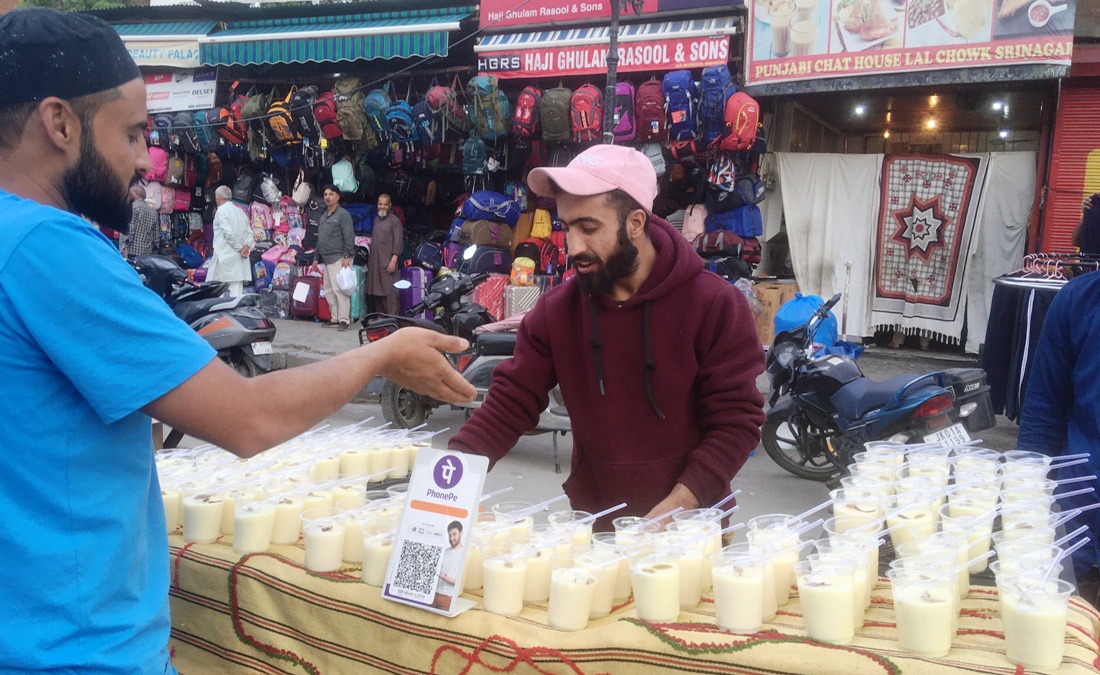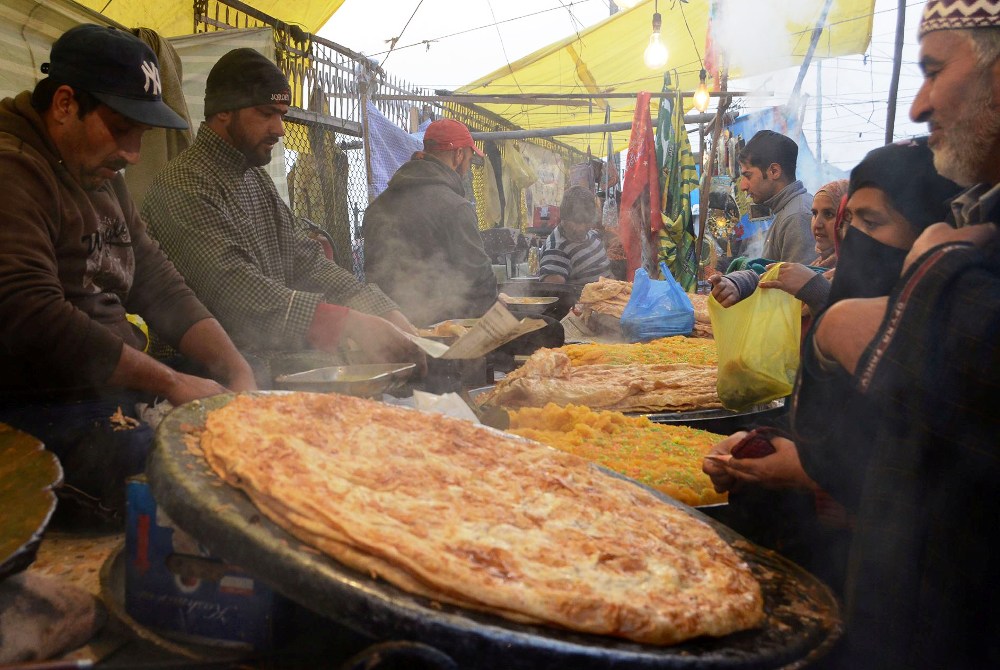Kashmir is famous for its multicourse mutton cuisine, the Wazwaan. That, however, never means that there are no candies and sweetmeats endemic to Kashmir, writes MJ Aslam

Kashmir has remained famous for its food. It is as true with vegetable-based preparations as it is with non-vegetarian cuisine. There is a basket of candies and sweetmeats too.
Halwa
Everyone knows about Halwa. The sweetmeat was originally made of honey, camel’s milk, cashew nuts, and many other ingredients and brought from the Persian Gulf, via Bombay, in saucers to United India in the nineteenth century. Before that Halwa was unknown in India. Now, there are varieties of Halwa known all over India, Pakistan, Bangladesh, Arabia, Persia and other parts of the world.
Historically, its origin lies in Persia (Iran), where it spread initially to Ottoman Turk Empire, Arabia, the Middle East and then to India.
Halwai is the one who prepares and sells the sweetmeat. Both terms have origins in Persian-Muslim food traditions. With the passage of time, Halwai became a term to denote the maker and seller of all kinds of sweetmeats or simple sweets.
In Kashmir, Halwa tradition must have reached towards the end of the nineteenth century as Halwa and Halwai were the names now known in Kashmir. However, it was non-Kashmiri Muslim Halwais from other parts of India who by 1980 started introducing and setting up their shops of Halwa-Paratha outside Kashmir shrines.
Some local Muslim Monje Ghier copied it from them. Monj e Gour makes and sells vegetable fritters and fried snacks called Monjgir Soda in Kashmiri’s common parlance. A variety of items like Nadir Monji, Alve Pakode, Gunde te Palki Pakode, Til e Kareh, Til e Goji and Monjgir Gade, are prepared by dipping lotus-stem-pieces [Nadru], slices of potatoes, onions and spinach, chickpeas, the kernel of water chestnuts and fish, respectively, in spiced-batter and then deep fried. Paratha is also deep-fried in mustard oil. The confectionery items prepared and sold by Monj e Gor are Khand e Gazri, Lala Shangrum and Busrakh.
Phirini, Pulav
Like Halwa, Phirni, an after-meal-dessert, a sweet pudding of condensed milk with Soji mixed with dry fruit like raisins, almonds, cashews, and pistachios, sprinkled with rose-water, has also Persio-Turkish origin. Muslims prepare other rich and aromatic sweet dishes of Pulav, mixed with almonds, and raisins and strewn with ghee and saffron.
Nabad, Honey
Sugarcane does not grow in Kashmir. Sugar was exclusively imported from erstwhile united Punjab up to 1947 but it was among the costliest imports to Kashmir. Kashmiris were fond of sugar. From Kashmir, Punjab sugar was sent via Leh to Changthang, Lhasas and then to Yarqand and Kashghar. It came in two forms brown colour sugar, which was called Batas, and white colour sugar which was called Nabad. Brown sugar is the shakar in Persian and Khaa’nd in Punjabi. But, in Kashmir, over decades, Khaa’nd became Khand, which is invariably used for white sugar crystals used by people.
Common sugar is known to Kashmiris, though originally when its import began to Kashmir in the nineteenth century from Punjab, it was called Nabad or Nabat. And, with the passage of time, Nabad denoted crystallised sugar into a big round ball.
It was mainly white loaves of Nabad that were consumed by Kashmiris in Kahwah and some food items. Nabat is a Persian word meaning sugar. Its modified Kashmiri version is Nabad. Nabad, as we know and understand in Kashmir, is sugar crystallized in an earthen pot or a copper container like No’ut and then carved out as a solid sugar ball in a semi-round shape, bigger than a football. It was done by Halwais or Monje-girs who supplied it to dry-fruit sellers and grocers for sale. Pieces of Nabad are called Kuza or Kuze.
It may be noted here that the small earthen dishes or pots in which sugar was crystallised and manufactured into what is commonly known as Nabad Nut were removed preparatory for the purpose of easy transportation of Punjabi sugar to Tibet and Central Asia via Leh. In Kashmir, however, Nabad No’ut retained its place in marital and betrothal gifts that were exchanged by the families of bride and bridegroom at the time of what was commonly known as Nabad-Nishain.

The tradition was that the Nabad No’ut was carried by a middleman on his head while the boy’s mother and close female relatives followed him to the girl’s home. At the girl’s parental home, the mothers of the boy and girl would exchange Nabad-Kuze with swearing in sacred words of giving and taking young couple as husband and wife. Since this odd custom conflicted with the set procedure of Nikah Khawani in Islam, the tradition of Nabad-Nishain has disappeared from Kashmirian society since.
It may be noticed that Khand, Misri, Shakar and Gur are all different varieties derived from sugarcane.
Lawrence had suggested to the then Dogra government, an alternative to the sugarcane plants of cultivating sugar maple and beetroot sugar in Kashmir but the suggestion could not materialize. What people used in making Kahwah and food items like Pulao, Halwa, Phirni, etc, in the past, when sugar was not imported to Kashmir? They used honey!! The oldest known method of honey-making was adopted by Kashmiris. Even when sugar was coming to Kashmir in the past, many people resorted to this oldest known procedure of homemade honey as an alternative to sugar.
What was that method? In the past, houses were built of wood and mud. A round hole was dug inside-out in the wall of the house in which a tube 14 inches wide and 22 inches long of baked clay (pottery, earthenware) lined with a plastering of clay mortar, which was worked up with the husk of rice or with thistle-down, was inserted in the wall-hole. The outer side of the orifice of the hole was covered with a red pottery-ware disk (like Anuit) with some openings in it for the bees to enter the tube. On the mouth of the tube inside the house, a similar pottery plate was tightly fitted with plaster of clay and husk. When the comb was fit to be taken, the house owner would burn some grass near the orifice from outside causing the bees to come out and the owner collected the honey from the tube inside by removing the pottery dish from it.
Gulkand
Gul, rose petals, Kand, sugar or honey. Gulkand is the conservation of Kashmiri rose petals or candied Kashmiri roses (Kashur Gulab). Non-Kashmiri roses are not used in their formulation. In Kashmir, it was and is made of native heart-captivating, pink, elegant, scented rose petals mixed with sugar. In place of sugar, honey can also be mixed with rose petals to prepare the herbal formulation of Gulkand. Sugar and rose petals are pounded together in a traditional way for making Gulkand.
There is no historical record that it was exported from Kashmir to Punjab, Leh, Yarkand or Central Asian countries in the past. However, according to a late Kashmiri author in “his unpublished work”, Gulab Singh laid out Gulab Bagh of rose trees at Srinagar with the purpose of manufacturing Gulkand and exporting it to Punjab where sweet jams were in much demand those days, he writes.
The cited area that skirts the Kute Kol in North-West is Gulab Bagh in the larger part of which in the Bakhshi-regime came the formal Food and Supplies Department, though it was used in the Dogra period also what was known as Shali-Store. Shaheed Gunj PS was also built on part of it. Then, a ground in the backyard of the Food and Supplies Department [now Consumer Affairs Department] embracing the Kute Kol in the North-West was used for sports like football matches between departmental-football teams of Kashmir like Food and Supplies Department, SRTC/Transport, KMDA, Forest Department, Kashmir University and so on, during Bakhshi, Sadiq, Qasim, period till the early 1980s.
Recently, after reading down of Article 370, the said football ground from Mandir side of Chota Bazar on Kote Kol has been converted into an FCI food-supplies-store. But Gulab Singh having ever intended making of Gulkand is imaginary though on record, he had laid out this garden. This author could not find it from the “primary Persian source” anywhere the late writer has referred to and quoted in support of the claim that Gulab Singh Dogra wanted to prepare Gulkand of the roses of the Gulab Bagh: albeit, the garden was laid out by him. The Gulab Bagh in question should not be confounded with the commonly known Gulab Bagh of Alestaing (Ganderbal).
Kashmiris, both in rural and urban areas, prepared Gulkand at home for family consumption. Once prepared and packed in glass jars or bottles, it could be consumed for a long period of time. The pottery or earthenware jars are not good for keeping Gulkand as the moisture of the candied jam will be absorbed by the earthenware jar, squeezing juice from the pulp and making it dry and hard. So pottery and plastic jars and bottles are not used for Gulkand keeping and packing. Once prepared and put in jars, it goes on for years and years. This sweet rose-candied jam remains fresh and eatable for years. With honey, it becomes very powerful for body heat during cold seasons. Obviously, due to the availability of roses in summer, it is prepared generally in summer. It is still produced with Araqi Gulab from roses in Kashmir and sold in markets.
The origin of Gulkand is traced to Yarqand where it was very largely manufactured and it is known there by the same name as Gulkand. Kashmir had commercial and cultural relations with Yarqand and other Central Asian countries over centuries.
Gulkand must have been brought to Kashmir by the local and Yarqandi traders in the past. Huge commerce was going on between Central Asia and Kashmir for hundreds of years. Yarqand Sarai at Safa Kadal and Kaka Sarai near SMHS, Srinagar (on the latter site a private hospital has been built recently) are extant examples of the trade centres and commercial connections between Central Asia and Kashmir.
The Rose Atr
It may be noticed that otto /ottar of roses was introduced in the Indian subcontinent by Empress Nur Jahan in cooperation with her mother, Asmat Begum. Muslim rulers greatly improved upon the production of perfume-making in India. Otto of roses was a special fragrance used by nobles and common people alike as it is a rich Islamic tradition connected with Muslim religious rituals, festivals and worship.
The maintenance of rose gardens for distillation of rose water (Arqi Gulab) or rose-otto (Atri Gulab) or Gulkand requires constant care by the cultivators from the time of planting rose trees or rose-cuttings from nurseries to the time of harvest when roses are plucked in lakhs for the said purposes. The rose trees come into flower at the beginning of March and continue so through April and May.

In large rose gardens for the aforementioned objectives, flowers are plucked early morning by the gardeners engaged by the owners-cultivators in large bags and baskets which are then sold to the contractors (thakidars) for the said purposes.
Regular watering, pruning and high-quality manure feed for rose cultivation are absolutely essential for an industry of rose jams, rose water and rose ottar or for any medicinal and cosmetic purpose. Nothing of these sorts is mentioned about the Srinagar’s Gulab-Bagh in the Persian chronicle referred to by the late Pandit author in his “unpublished monograph” copy whereof is lying with me.
from Kashmir Life https://ift.tt/z4ZGCFH
via IFTTThttps://kashmirlife.net
No comments:
Post a Comment